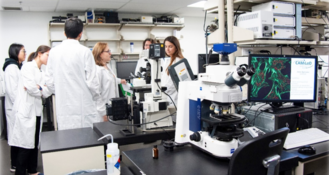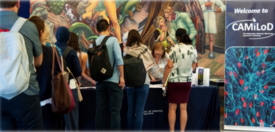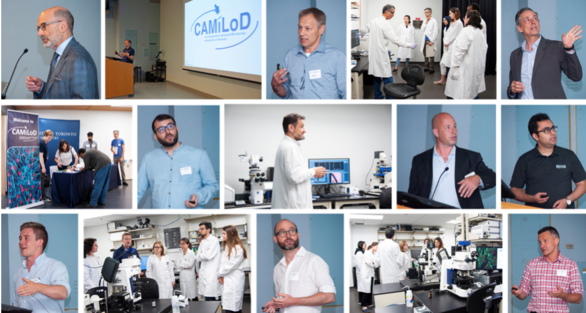University of Toronto Faculty of Dentistry
The University of Toronto Faculty of Dentistry is a dental school located in Toronto, Ontario, Canada. It is one of the ten dental schools in Canada.[1] It is the largest dental school in Canada with a range of undergraduate and graduate level programs and an enrolment of around 610 students (not including specialty or residency programs). The faculty is located at the heart of Downtown Toronto's Discovery District, a neighbourhood with a high concentration of hospitals and research institutes, just south of the University of Toronto's St. George campus. In 2014, the Faculty of Dentistry joined the Toronto Addis Ababa Academic Collaboration (TAAAC), providing support in building capacity for oral health in Ethiopia by creating collaborative teaching opportunities.[2]
 The faculty building | |
Former names | Royal College of Dental Surgeons |
|---|---|
| Type | Private |
| Established | 1875 |
Parent institution | University of Toronto |
| Dean | Daniel Haas |
| Students | 610 |
| Location | , , |
| Website | dentistry |
History
In 1868, the Province of Ontario passed the "Act Respecting Dentistry".[3] This Act granted the Royal College of Dental Surgeons of Ontario (RCDSO) dual responsibilities of licensing and dental education in Ontario. In 1875, the Royal College of Dental Surgeons was founded, with its first semester schedule to start on November 3, 1875.[4] Under the Act, the RCDS could grant a Licentiate of Dental Surgery (LDS), which was not a formal degree, but training that granted those interested in a license to practice dentistry in Ontario.[5] James Branston Willmott was the first Dean of the school. Dr. Willmott, joined by Dr. Luke Teskey were the only two professors guiding the first class of eleven students in 1875–1876.[6] The RCDS established an affiliation with the University of Toronto in 1888, but it was not until 1889 that it granted the Doctor of Dental Surgery (DDS) degrees.[7] In 1925, the RCDS became the Faculty of Dentistry at the University of Toronto.
One of the alumni of the Faculty of Dentistry, Dr. Harold Keith Box, DDS, PhD (1890–1956), was as a stakeholder in establishing the Canadian Dental Association Research Foundation (CDAF), organized by a committee of the Canadian Dental Association.[8] The CDAF was the first of its kind in Canada, an organization that focused on providing funding for dental research projects in Canadian dental schools.[9] Due to his contribution to the establishment of the CDAF and the various publications that emerged from his work, Dr. Harold Keith Box is known as the father of dental research in Canada.[10] The Faculty of Dentistry continued to contribute to dental research initiatives and became a distinguished contributor at the international level. In 1921, International Association of Dental Research had four chapters, one of which was in Toronto (in addition to Chicago, Boston and New York).[11] In 1927, the IADR Toronto Chapter was successful in receiving funds for the first hospital internship that ensured students had four free hours per day so that they could devote time to research.[12]
In 1945, after years of negotiations, three University of Toronto Faculty of Dentistry professors, Dr. Frank Lott, Dr. Harvey Reid and Dr. Roy G. Ellis, in their role as members of the CDA Research Committee, were able to secure funding for dental research from the National Research Council of Canada.[13] This ensured that generations of dental researchers had access to funding. With the continuous flow of funding, the Faculty of Dentistry was able to establish the first Dental Public Health specialty in 1946,[14] and with its inception began a long history of effort in research and initiatives that would influence oral health policies in Canada.
Curriculum
The Faculty offers a number of programs. The undergraduate programs include a four-year internationally recognized dental degree Doctor of Dental Surgery (DDS), and an International Dentist Advanced Placement Program (IDAPP). Graduate studies programs include MSc or PhD with a research option or in one of ten dental specialty training options, including Dental Anesthesia, Dental Public Health, Endodontics, Oral and Maxillofacial Radiology, Oral and Maxillofacial Surgery, Oral and Maxillofacial Pathology and/or Oral Medicine, Orthodontics and Dentofacial Orthopedics, Paediatric Dentistry, Periodontics, and Prosthodontics.[15] Approximately 13 yearly residencies for the dental specialty training are available at several of Toronto's teaching hospitals, namely The Hospital for Sick Children, Mount Sinai Hospital, and Sunnybrook Health Sciences Centre.[16] The Faculty also hosts ongoing onsite and online courses and workshops for dental professionals through their Continuing Dental Education unit.[17]
Research
The Faculty of Dentistry has various research foci, including Biomaterials and Biomedical Engineering, Connective Tissues and Regenerative Medicine, Dental Public Health, Education Research, Microbiology, Oral Pathology and Cancer, and Pain and Neuroscience.[18] In addition, the Faculty of Dentistry, in collaboration with the Faculty of Medicine and the Faculty of Applied Science and Engineering, has established the world-renowned Institute of Biomaterials and Biomedical Engineering (IBBME).[18]
New Imaging Research Facility
Further, the Faculty of Dentistry, in 2019, had initiated a new and innovative research imaging facility, dedicated to the Research community of the Greater Toronto Area (GTA).[19] The facility is known as CAMiLoD, which stands for The Collaborative Advanced Microscopy Laboratories of Dentistry. The facility was established by Faculty of Dentistry's distinguished professor, Dr. Boris Hinz who envisions this facility as a means of empowering and facilitating researchers of all stripes, by rendering Advanced Microscopy and dedicated image analysis services for studying cells, tissues, and all sorts of specimens

The facility has access to the most innovative microscopy which are accompanied by latest cutting edge technologies and specialized softwares intended to amplify the scope of research and quantitative analysis for investigators.[20]
Dr Hinz, the Director of CAMiLoD, articulates that the facility's integrated cell culture approach and diversified microscopy that produce 3D and 4D, high resolution images can be extremely beneficial for every researcher.[21] CAMiloD provides its users with Atomic Force Microscopy (AFM), light and hard electron microscopy, Confocal, Sliding Electron Microscopy, Epifluorescence microscopes, Wide Field Microscopy and several other options.
Whether a researcher is endeavouring to view and analyze cells from various angles, view live cells, or study small particles which requires innovative microscopy, CAMiLoD is assisting researchers and students with such scientific tasks[22]
CAMiLoD is a research hub for all researchers in the life-sciences and Biomedical field, whether a student or researcher has microscopy and imaging data analysis needs, or a Biotech and Pharmaceutical company is in need of a research facility, CAMiLoD has its door open. By being UofT's core state-of-the-art imaging facility, CAMiloD seeks to empower the research community by collaborating with industry partners, that are seeking to enhance and further their scientific research.[23]

In addition, also being Toronto's core and most innovative microscopy laboratory, CAMiLoD offers a variety of meaningful and experiential events for its users. Which include but are not limited to:
- Microscopy Training Workshops
- Online Workshops
- Courses
- Seminars
- Customized Image Analysis
- One-on-one Training
- Networking Events and Hackathons[24]

References
- Canadian Dental Association (2018" -said by Daniel Haas, Dean of the Faculty of Dentistry.- Said by Daniel Haas, Dean of the Faculty of Dentistry.. Canadian Dental Schools. Available from https://www.cda-adc.ca/en/becoming/dat/information/schools/
- Toronto Addis Ababa Academic Collaboration (2018). About us, Available from http://taaac.com/programs/dentistry/
- Ontario Dental Association (2017). An Act Respecting Dentistry. Available from http://150.oda.ca/wp-content/uploads/2016/11/ActRespectingDentistry-1.pdf
- Gullet,D. W. (1971) A history of dentistry in Canada, University of Toronto Press, p. 58
- Gullet,D. W. (1971) A history of dentistry in Canada, University of Toronto Press, p.60
- Gullet,D. W. (1971) A history of dentistry in Canada, University of Toronto Press, p.61
- Gullet,D. W. (1971) A history of dentistry in Canada, University of Toronto Press, p. 58
- Shosenberg, JW. (2017).The rise of the Ontario Dental Association: 150 years of organized dentistry, Toronto, Ontario Dental Association, p. 40-41
- Shosenberg, JW. (2017) The rise of the Ontario Dental Association: 150 years of organized dentistry, Toronto, Ontario Dental Association, p. 40-41
- Shosenberg, JW. (2017). The rise of the Ontario Dental Association: 150 years of organized dentistry, Toronto, Ontario Dental Association, p. 40-41
- Shosenberg, JW. (2017). The rise of the Ontario Dental Association: 150 years of organized dentistry, Toronto, Ontario Dental Association, p. 215
- Shosenberg, JW. (2017). The rise of the Ontario Dental Association: 150 years of organized dentistry, Toronto, Ontario Dental Association, p. 216
- Shosenberg, JW. (2017). The rise of the Ontario Dental Association: 150 years of organized dentistry, Toronto, Ontario Dental Association, p. 217
- Shosenberg, JW. (2017). The rise of the Ontario Dental Association: 150 years of organized dentistry, Toronto, Ontario Dental Association, p. 219
- "Programs". Faculty of Dentistry, University of Toronto. Retrieved 2018-11-07.
- "Programs - Hospital Dental Residency Program". Faculty of Dentistry, University of Toronto. Retrieved 2018-11-07.
- "FAQ | Continuing Dental Education". cde.dentistry.utoronto.ca. Retrieved 2018-11-07.
- Faculty of Dentistry, University of Toronto (2018). Research, Available from https://www.dentistry.utoronto.ca/research
- "Welcome to CAMiLoD | Faculty of Dentistry, University of Toronto". www.dentistry.utoronto.ca. Retrieved 2020-07-20.
- "Welcome to CAMiLoD | Faculty of Dentistry, University of Toronto". www.dentistry.utoronto.ca. Retrieved 2020-07-20.
- "Boris Hinz | Faculty of Dentistry, University of Toronto". www.dentistry.utoronto.ca. Retrieved 2020-07-20.
- "Boris Hinz | Faculty of Dentistry, University of Toronto". www.dentistry.utoronto.ca. Retrieved 2020-07-20.
- "U of T Faculty of Dentistry opens state-of-the-art imaging facility for researchers". University of Toronto News. Retrieved 2020-07-20.
- "Courses and Events | CAMiLoD | Ontario". CAMiLoD. Retrieved 2020-07-20.
External links
- University of Toronto Faculty of Dentistry
- Royal College of Dental Surgeons of Ontario
- University of Toronto, Ontario, Canada
- "Welcome to CAMiLoD | Faculty of Dentistry, University of Toronto". www.dentistry.utoronto.ca. Retrieved 2020-07-20.
- "Welcome to CAMiLoD | Faculty of Dentistry, University of Toronto". www.dentistry.utoronto.ca. Retrieved 2020-07-20.
